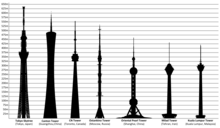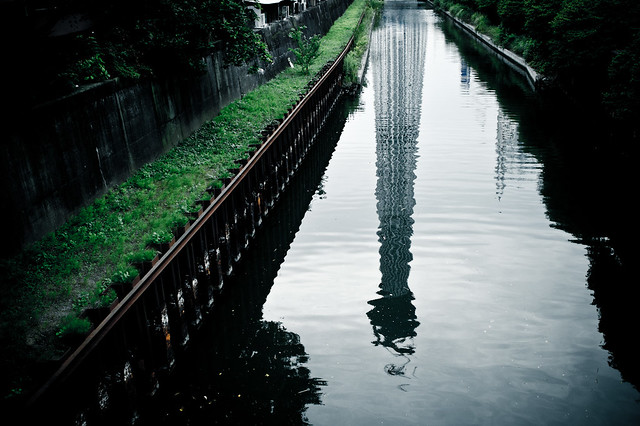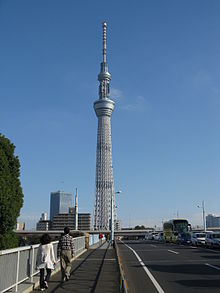Seattle's 600 ft 1962 Space Needle gets a new 2000 ft rival in Tokyo, which previously just had a clone of the Eiffel tower as the "Tokyo Tower". If you want to go up, you'll have to get in line with online reservations on their home webpage.
Wikipedia: Tokyo Sky Tree (東京スカイツリー Tōkyō Sukai Tsurī), formerly known as New Tokyo Tower(新東京タワー Shin Tōkyō Tawā), is a broadcasting, restaurant, and observation tower in Sumida, Tokyo, Japan. It became the tallest structure in Japan in 2010[1] and reached its full height of 634.0 metres (2,080 ft) in March 2011, making it the tallest tower in the world, displacing theCanton Tower,[2][3] and the second tallest structure in the world after Burj Khalifa (829.84 m/2,723 ft).
NHK takes you up the tower, with tips on how to get a picture against the tower (on the ground, or use mirrors set up by nearby shops) and Sky Tree themed waffles and onion ring towers.
see a slideshow of his set


From October to November 2007, suggestions were collected from the general public for the name to be given to the tower. On 19 March 2008, a committee chose six final candidate names: Tokyo Edo Tower, Tokyo Sky Tree, Mirai Tree, Yumemi Yagura, Rising East Tower, and Rising Tower, with the official name to be decided in a nationwide vote. On 10 June 2008, the official name of the tower was announced as "Tokyo Sky Tree". The name received around 33,000 votes (30%) out of 110,000 cast, with the second most popular name being "Tokyo Edo Tower".[7]
Wikipedia: Tokyo Sky Tree (東京スカイツリー Tōkyō Sukai Tsurī), formerly known as New Tokyo Tower(新東京タワー Shin Tōkyō Tawā), is a broadcasting, restaurant, and observation tower in Sumida, Tokyo, Japan. It became the tallest structure in Japan in 2010[1] and reached its full height of 634.0 metres (2,080 ft) in March 2011, making it the tallest tower in the world, displacing theCanton Tower,[2][3] and the second tallest structure in the world after Burj Khalifa (829.84 m/2,723 ft).
NHK takes you up the tower, with tips on how to get a picture against the tower (on the ground, or use mirrors set up by nearby shops) and Sky Tree themed waffles and onion ring towers.
see a slideshow of his set
 |
| by jamesjustin |
Tokyo Sky Tree
From Wikipedia, the free encyclopedia
Tokyo Sky Tree 東京スカイツリー 
Tokyo Sky Tree under construction in March 2011General information Status Complete Type Broadcast, restaurant, and observation tower Location Sumida, Tokyo, Japan Coordinates 35°42′36.5″N 139°48′39″ECoordinates: 35°42′36.5″N 139°48′39″E Construction started 14 July 2008 Completed 29 February 2012 Opening 22 May 2012 Cost 40 billion JPY (440 million USD) Height Antenna spire 634.0 m (2,080 ft) Roof 495.0 m (1,624 ft) Top floor 450.0 m (1,476 ft) Technical details Elevators 13 Design and construction Owner Tobu Tower Sky Tree Co., Ltd. Main contractor Obayashi Corp. Architect Nikken Sekkei Developer Tobu Railway Website www.tokyo-skytree.jp/english/
Tokyo Sky Tree (東京スカイツリー Tōkyō Sukai Tsurī?), formerly known as New Tokyo Tower(新東京タワー Shin Tōkyō Tawā?), is a broadcasting, restaurant, and observation tower in Sumida, Tokyo, Japan. It became the tallest structure in Japan in 2010[1] and reached its full height of 634.0 metres (2,080 ft) in March 2011, making it the tallest tower in the world, displacing theCanton Tower, and the second tallest structure in the world after Burj Khalifa (829.84 m/2,723 ft).
Led by Tobu Railway and a group of six terrestrial broadcasters headed by NHK, the tower project forms the centrepiece of a large commercial development equidistant from Tokyo Skytree andOshiage train stations, 7 km (4.3 mi) north-east of Tokyo station. One of its main purposes is to relay television and radio broadcast signals; Tokyo's current facility, Tokyo Tower with a height of 333 m (1,093 ft), no longer gives complete digital terrestrial television broadcasting coverage because it is surrounded by many high-rise buildings. The project was completed on 29 February 2012, with the tower's public opening due on 22 May 2012.[4]
Design

Tokyo Sky Tree under construction in March 2011
The design was published on 24 November 2006, based on the following three concepts.
- Fusion of futuristic design and traditional beauty of Japan,
- Catalyst for revitalization of the city,
- Contribution to disaster prevention "Safety and Security".
The base of the tower has a structure similar to a tripod; from a height of about 350 m (1,150 ft) and above, the tower's structure is cylindrical to withstand very strong winds.[citation needed]
There are observatories at 350 m (1,150 ft) and 450 m (1,480 ft).
[edit]Earthquake resistance
The tower has seismic proofing, including a central shaft made of reinforced concrete. The main internal pillar is attached to the outer tower structure 125 meters (410 ft) above ground. From there until 375 meters (1,230 ft) the pillar is attached to the tower frame with oil dampers, which act as cushions during an earthquake. According to the designers, the dampers can absorb 50 percent of the energy from an earthquake.[5]
[edit]Colour
The exterior lattice is painted a colour officially called "Sky Tree White". This is an original colour based on a bluish white traditional Japanese colour called aijiro (藍白).[6]
[edit]Illumination
The illumination design was published on 16 October 2009. Two illumination patterns (sky blue and purple) will be used, alternating daily. The tower is illuminated using LED lights.
[edit]Naming and height


From October to November 2007, suggestions were collected from the general public for the name to be given to the tower. On 19 March 2008, a committee chose six final candidate names: Tokyo Edo Tower, Tokyo Sky Tree, Mirai Tree, Yumemi Yagura, Rising East Tower, and Rising Tower, with the official name to be decided in a nationwide vote. On 10 June 2008, the official name of the tower was announced as "Tokyo Sky Tree". The name received around 33,000 votes (30%) out of 110,000 cast, with the second most popular name being "Tokyo Edo Tower".[7]
The height of 634 m (2,080 ft) was selected to be easily remembered. The figures 6 (mu), 3 (sa), 4 (shi) stand for "Musashi" an old name of the region where the Tokyo Sky Tree stands.
[edit]Broadcasting use
Tokyo Sky Tree will be used as a radio/television broadcast and communications tower.
[edit]Television broadcasters
| Channel | Channel name | Callsign | Signal power | Broadcast area |
|---|---|---|---|---|
| NHK General TV / NHK G (GTV) | JOAK-DTV | 10 kW | Kantō (except Ibaraki Prefecture) | |
| NHK Educational TV / NHK E (ETV) | JOAB-DTV | All Japan | ||
| Nippon Television / Nittele (NTV) | JOAX-DTV | All Kantō | ||
| TV Asahi / Tele-Asa (EX) | JOEX-DTV | |||
| TBS | JORX-DTV | |||
| TV Tokyo / Teleto (TX) | JOTX-DTV | |||
| Fuji Television (CX) | JOCX-DTV | |||
| Tokyo Metropolitan Television / Tokyo MX | JOMX-DTV | 3 kW | Tokyo |
[edit]FM radio broadcasters
| Frequency | Station name | Callsign | ERP | Broadcast area |
|---|---|---|---|---|
| 81.3 MHz | J-Wave | JOAV-FM | 44 kW | Tokyo |
| 82.5 MHz | NHK Tokyo FM | JOAK-FM |
[edit]
[edit]External links
| Wikimedia Commons has media related to: Tokyo Sky Tree |
- Official website (English)
- Tokyo Sky Tree construction site webcam (available Monday–Saturday 9:00–17:00 Japan Standard Time only) (Japanese)


No comments:
Post a Comment